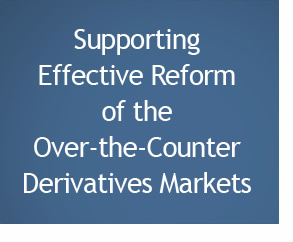08/19/10 - The New York Times - Gretchen Morgenson
|
|
Fair Game: It’s Not Over Until It’s in the Rules
NOW for the heavy lifting.
Having passed the Dodd-Frank Act earlier this summer, the bill that aspires to reorder our financial universe in the wake of the most serious economic crisis in generations, Congress has moved on to other matters. Regulators are left to write the rules that will make financial reform a reality — or not — and are beginning that laborious process.
The Commodity Futures Trading Commission is one regulator with a lot on its plate. Last month, the commission published a list of 30 areas related to over-the-counter derivatives that require new rules. Derivatives, you might remember, are the exotic securities that Wall Street engineered to hedge risk, only to discover during the mortgage meltdown that the contracts — which linked together a dizzying number of financial players — actually amplified the severity of the crisis.
On Aug. 20, the Commodity Futures Trading Commission and the Securities and Exchange Commission sponsored an open forum on derivatives regulation. Industry representatives, trade groups, investor advocates and regulators discussed how to put into practice Congress’s desire for a more closely supervised market in derivatives.
Because the most potentially nuclear forms of derivatives are privately arranged and loosely monitored, two clear goals of the legislation are greater price transparency and the opening of transactions to more market participants.
But not everyone wants these aims to be met. And early signs indicate that the big firms currently in control of the derivatives market view the rules-writing process as an opportunity to maintain the status quo in one of their most lucrative lines of business — or win back what they feel they lost amid the legislative wrangling earlier this year.
The question is this: Will regulators give Wall Street’s big dealers what they want in a second bite of the apple?
There is no doubt that regulating the freewheeling derivatives market is important work. If done right, heightened scrutiny could well eliminate the potential for another disastrous bank run like the one that threatened world markets in September 2008 when the American International Group imploded. The insurer had written insurance on mortgage securities— a derivative known as a credit default swap — and almost collapsed after, among other things, onerous collateral calls from its trading partners drained its cash.
Changing the way this market operates is also crucial because major firms like JPMorgan Chase, Goldman Sachs and Morgan Stanley currently run it. These companies don’t want to open trading facilities to more participants because they prefer that their customers have limited access to bids and offers; such black-box arrangements generate far more profits to dealers than open and transparent markets.
Congress wisely recommended broadening access to an array of prices so that customers trading swaps could get a feel for what they might pay or receive for an instrument before they committed to a transaction — a process known as pretrade price transparency. Carrying out this goal is where it gets tricky, and where the existing dealers hope to protect their profits.
It promises to be a hard-fought scrimmage.
“It is again going back to the battlefield, and this is a much more complicated battlefield,” said Michael Greenberger, a professor at the University of Maryland School of Law and a former director of trading and markets at the Commodity Futures Trading Commission. “It is technically hard lawyering, gathering your evidence and making your point. Anybody who thought this game is over or that it couldn’t be reversed through the agency process is kidding themselves.”
Two important elements of the argument are how the facilities and clearinghouses that trade derivatives will be structured and who will be allowed to operate and participate in them. Control of both now lies with the dominant Wall Street firms, and they want to keep it that way.
Ninety percent of swaps are traded through the 10 biggest banks, generating revenue of an estimated $60 billion a year for these institutions, according to the Swaps and Derivatives Market Association, a membership organization that consists of firms hoping to compete with the big derivatives dealers in these markets.
A trading system that provides its customers with just a few bids and offers is far less transparent and significantly more costly to users than one presenting a long list of prices and participants ready to transact. To keep new participants out of the business of clearing trades, the established firms have rules requiring incoming members to hold a certain amount of net capital — in some cases $5 billion — and they want to keep these thresholds intact.
While such a requirement sounds like a way to reduce risk in the market by ensuring that only players with deep pockets are allowed in, some analysts say it heightens risk by eliminating competition and allowing the system to be dominated by institutions that are too big and politically interconnected to fail.
“For clearing of credit default swaps and interest rate swaps to actually work and lessen the systemic risk they pose to the global financial payments system, you need to have multiple clearing brokers involved with the clearinghouse to distribute the risk,” said Michael Hisler, a co-founder of the Swaps and Derivatives Market Association. “You also need multiple dealers to provide liquidity and continuity in markets in times of crisis.”
By controlling swaps clearinghouses, big firms have the power to decide which transactions can be cleared and which cannot. If the banks decide that certain contracts — usually intricately tailored financial arrangements sometimes known as “bespoke” agreements — can’t be cleared, the deals are moved out of the clearinghouses and into private hands. This limits how transparent the pricing is for bespoke contracts, which is one of the reasons they remain among the most lucrative pieces of the derivatives market for Wall Street.
Recognizing that Wall Street’s control of clearinghouses would likely thwart the development of a deep and open market, Congress initially limited dealer ownership of an operation to 20 percent. But by the end of the legislative process, that hard limit had disappeared. It was replaced by softer language giving the Commodity Futures Trading Commission power to restrict ownership without actually requiring it to do so.
What kind of limits regulators may place on ownership of these facilities is shaping up as a crucial skirmish, and some investor advocates are concerned that Wall Street may win it.
“There is going to be so much pressure from the biggest financial institutions not to have limits,” said Heather Slavkin, senior policy adviser of the A.F.L.-C.I.O.’s Office of Investment and a participant in the Aug. 20 meeting. “Regulators are going to be very much focused on what types of swaps get cleared, so the governance and ownership aspects that are just as important may not get the attention they deserve.”
IT’S entirely predictable that the big firms that have so dominated the swaps market will do all they can to hang on to their hegemony. After all, swaps trading is one of the last bastions of lush profitability, and Wall Street is desperate to protect it.
And it’s clever that the banks, given the crisis we have just experienced, are suggesting that safety and soundness in the derivatives market will be improved by erecting barriers based on capital requirements. But let’s hope the nation’s regulators recognize that expanding the numbers of participants in the market will benefit far more people than will be helped by keeping things the way they are now.
The status quo didn’t work very well for taxpayers, as you might recall. |



